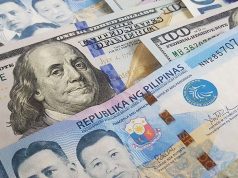Poll bares muted GDP view for 2018
ECONOMIC OUTPUT growth likely missed the official goal in the fourth quarter and full-year 2018, even as it is expected to remain above six percent, results of a BusinessWorld poll showed.
A poll of 16 analysts conducted late last week yielded a gross domestic product (GDP) growth estimate of 6.3% for both the October-December period and full-year 2018.

The quarterly estimate was faster than the third quarter’s 6.1% but slower than the 6.5% of 2017’s final three months.
The annual estimate, meanwhile, was below 2017’s 6.7% actual pace and the downward-revised 6.5%-6.9% target set by the government for 2018.
Nevertheless, the fourth-quarter estimate would extend the economy’s streak of at least six-percent growth to 15 straight quarters should it be realized. For the 2018 estimate, it may extend to seven straight years.
Official GDP growth data will be released on Thursday by the Philippine Statistics Authority (PSA), a day after the release of the PSA’s fourth-quarter data on farm production, which has historically contributed nearly a tenth to GDP.
GDP growth slowed to 6.3% in last year’s first three quarters from the 6.8% in the same period in 2017 on account of easing household consumption amid a surge in the prices of widely used goods.
Earlier this month, Socioeconomic Planning Secretary Ernesto M. Pernia said in a mobile phone message to BusinessWorld that the target is “still to hit 7-8% economic growth this year and thereafter.” In the National Economic and Development Authority’s year-end press briefing last month, Mr. Pernia — who heads the agency as director-general — said GDP growth should have hit seven percent in the fourth quarter in order to hit the revised 2018 target.
Capital Economics penciled in a six-percent GDP growth estimate for the fourth quarter in a research note, citing “another weakening in the economy” due to higher inflation that weighed on purchasing power.
ANZ Research gave a six percent estimate for the same quarter.
The poll’s 6.3% median estimate for 2018 compares with the World Bank’s 6.4%, the International Monetary Fund’s 6.5%, the Organization for Economic Cooperation and Development’s 6.7%, and the ASEAN+3 Macroeconomic Research Office’s 6.4%.
Economists cited the country’s inflation last year as a factor for the slowdown. Inflation averaged 5.2% in 2018, faster than 2017’s 3.3%, with October sustaining September’s nine-year-high 6.7% before the pace eased in November at six percent and December at 5.1%.
Inflation experienced by poor households — which put heavier weight on food, which was a key driver of 2018’s multiyear-high inflation, as well as other basic needs — was higher. It reached up to 9.5% in October, its fastest since 12.3% in the first quarter of 2009, before easing to 8.2% in November.
“In the early part of 2018, when inflation was rising, GDP growth slowed. Now that inflation has started to go down from the peak of 6.7% in October 2018 (the highest in nearly a decade), GDP growth could be faster starting 4Q 2018, assuming all other factors are the same,” said Rizal Commercial Banking Corp. economist Michael L. Ricafort, who pegged fourth-quarter 2018 GDP growth at 6.5% and the full-year rate at 6.4%.
He noted that global crude oil prices have already dropped by more than 30% after hitting a peak on Oct. 4 last year, and that prices of food items started to ease in 2018’s fourth quarter following state measures to facilitate food distribution.
Sun Life Financial economist Patrick M. Ella noted “that price adjustments of households and businesses have largely been over as these have been seen in the [second quarter] and [third quarter] GDP numbers, which reflected a marked slowdown in consumption growth.”
“Furthermore, seasonal spending coincided with price declines in energy and food, which should be positive for consumption growth in [the fourth quarter of 2018].”
Mr. Ella expects a year-on-year GDP growth rate of 6.5% in the fourth quarter and 6.1% for full-year 2018.
Nicholas Antonio T. Mapa, senior economist at ING Bank N.V. Manila Branch, gave a 5.9% growth estimate for the fourth quarter and 6.2% for the entire 2018, saying that higher-than-expected inflation figures had sapped the country’s “consumption momentum” along with the central bank’s 175-basis point hike. These factors led Mr. Mapa to “expect [fourth quarter] 2018 GDP to slip below six percent.”
Ling-Wei Chung, principal economist at IHS Markit, cited the country’s inflation spike last year for her fourth-quarter and full-year 2018 estimates of six percent and 6.2%, respectively. “Although inflation is easing and the central bank kept its policy rates on hold in December, their previous impact will continue to feed through the economy and take some toll on consumer and business spending,” Ms. Chung said.
For University of the Philippines economist Jefferson A. Arapoc, the economy likely grew by 6.3% in the fourth quarter and 6.4% last year. “[E]ven though our GDP continues to grow beyond six percent for the past 14 quarters, it must be noted that the Philippine economic performance for 2018 is far below market expectations…,” he said, adding that “inflation can still be considered as one its major culprits. In fact, inflation is cited as a major reason for the declining consumer and business outlook.”
At the same time, analysts said improved public sector spending fueled overall economic growth on the demand side, while manufacturing and services expansion drove the supply side.
“Economic expansion may have been largely driven by strong manufacturing demand, as evidenced by the [fourth quarter] as the strongest quarter for 2018 in terms of the seasonally adjusted Nikkei Philippines Manufacturing Purchasing Managers’ Index that measures manufacturers’ business and demand appetite,” said Ruben Carlo O. Asuncion, chief economist at Union Bank of the Philippines, Inc.
“Furthermore, the improvement of domestic consumption due to easing inflation, coupled with holiday spending, pushed [fourth quarter] higher in spite of the weakness in agriculture production,” Mr. Asuncion noted.
“Government spending may have also driven economic growth as it has in much of 2018.”
For University of Asia and the Pacific economist Cid L. Terosa: “Fourth-quarter GDP growth looks promising because of stronger manufacturing production, consistent service sector growth, high remittances and lower petroleum product prices.” He gave the fourth quarter and full-year GDP estimates of 6.3-6.4%.
The government spent a total of about P3.095 trillion as of end-November last year, 24% more than the P2.494 trillion spent in the same 11 months in 2017.
Furthermore, Department of Budget and Management data showed infrastructure and capital outlays growing 49.7% to P728.1 billion from P486.5 billion in the same comparable 11 months.
On the other hand, foreign trade remained a GDP damper, as the country posted a trade deficit of $37.687 billion in January-November, with imported goods growing by 15.8% versus a 0.9% contraction of merchandise exports. — Marissa Mae M. Ramos



